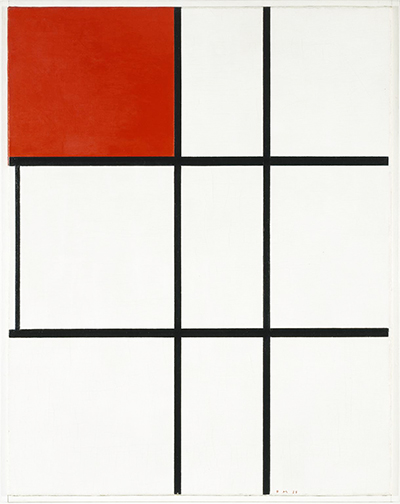Composition B (No.II) with Red from 1935 has been on an interesting journey during its lifetime, with the piece now residing within the Tate collection in the UK. Its abstract style makes it most suitable for the Tate Modern exhibition hall, from all of the different galleries that Tate currently run across the UK.
Mondrian continues to experiment here within his use of abstract shapes, forms and lines. In the example of Composition B (No.II) with Red, the artist keeps things fairly simple and most of the painting is devoted to the white background with black lines. The only other tone used is the bright red which adorns the top left corner. The artist slightly varies the thickness of his lines across the painting, with vertical lines being thinner than the horizontal ones, which just slightly adapts the balance of the piece. The spacing of these lines is also inconsistent, deliberately so. He does not attempt to make shapes equal in size across the work, though the red region is fairly square-like. Other blank regions are must more narrow, with one area to the left being particularly so. One black line to the left also just fills one part of the painting and does not continue vertically beyond that. It is fair to say that Mondrian took his arrangements of shape and line just as far as it could go during the 1920s and 1930s, leaving behind a huge number of different interpretations of this new abstract style, Composition with Red, Blue and Yellow being his most famous of all.
Composition in White and Blue and Composition in White Black and Red provide further examples of how the artist would sometimes reduce his abstract paintings down to almost entirely black and white compositions. This was an artist who was experimenting at different levels, firstly in periods of several years at a time, and then within particular approaches down to an even finer level. He would use expressive styles elsewhere and also create recognisable landscapes and portraits earlier on before transitioning into abstraction, which would ultimately be where he felt most comfortable. It was his relocation to Paris which brought about the biggest changes in this regard and that city brought a great amount of new influences into his life.
Those lucky enough to view the Tate collection across its many different galleries might come across a number of other artworks by Mondrian that are also within this possession. The uplifting Sun, Church in Zeeland; Zoutelande Church Facade is one such piece, and features a charming depiction of architecture within a contemporary style. They also have No. VI / Composition No.II which offers an alternative style of abstract art used by Mondrian as he went along his slow transition towards the style that we find within this page in which reality is finally left behind entirely. One today can marvel at the achievements of Mondrian in a number of major galleries across Europe, with his work spread far and wide. Some of his lesser known pieces still reside within private collections, but most of his major pieces have now been snapped up by public museums and galleries which allows the public to continue to enjoy his work relatively easily. Exhibitions of his work are also held fairly regularly and help to strengthen his reputation amongst the younger generations.




